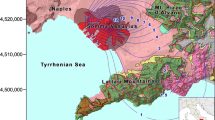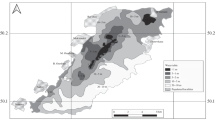Abstract
During explosive eruptions the deposition of fine-grained volcanic ash fallout reduces soil permeability, favouring runoff of meteoric water and thus increasing the occurrence of catastrophic floods. A fully dynamic, two-dimensional model was used to simulate flooding scenarios in the Vesuvian area following an explosive volcanic eruption. The highest risk occurs in the catchment area of the Acerra-Nola Plain N and NE of Vesuvius. This plain has a population of 70,000 living in low-lying areas. This catchment area is vulnerable to ash fall because it lies downwind of the dominant synoptic circulation and it lacks a natural outflow toward the sea. Our numerical simulations predict dangerous scenarios, even in quiescent periods, during extreme rain events (return periods of 200 years have been considered), and a significant increase in the extent of the flooded areas due to renewed volcanic activity. Based on these simulations a hazard zonation has been proposed.








Similar content being viewed by others
References
Andronico D, Cioni R (2002) Contrasting styles of Mount Vesuvius activity in the period between the Avellino and Pompeii Plinian eruptions, and some implications for the assessment of future hazards. Bull Volcanol 64:372–391
Arrighi S, Principe C, Rosi M (2001) Violent Strombolian and sub-Plinian eruptions at Vesuvius during post-1631 activity. Bull Volcanol 63:126–150
Barberi F, Macedonio G, Pareschi MT, Santacroce R (1990) Mapping tephra fallout risk: an example from Vesuvius, Italy. Nature 334:142–144
Barontini S (1999) Studio delle aree alluvionabili nel bacino del Clanio e del Lagno di Quindici in caso di eruzione al Vesuvio. Unpublished Thesis, University of Pisa, Facoltà di Ingegneria, 376 pp
Baxter PJ (1998) Human and structural vulnerability assessment for emergency planning in a future eruption of Vesuvius using volcanic simulation and casualty modelling. EC Project ENV4-CT98-0699 Final Report 51 pp
Bertagnini A, Landi P, Rosi M, Vigliargio A (1998) The Pomici di Base plinian eruption of Somma-Vesuvius. J Volcanol Geotherm Res 83:219–239
Bates PD, De Roo APJ (2000) A simple raster-based model for flood inundation simulation. J Hydrol 236:54–77
Calcaterra D, Parise M, Palma B, Pelella L (1999) The May 5th 1998, landsliding event in Campania (southern Italy): inventory of slope movements in the Quindici area. Yagi N et al. (eds) Proc. Int Symp on Slope Stability Engineering, Balkema, Rotterdam, 1361–1366
Calcaterra D, Parise M, Palma B, Pelella L (2000) Multiple debris-flows in volcaniclastic materials mantling carbonate slopes. Wieczorek GF, Naeser ND (eds) Debris-flow hazard mitigation: mechanics, prediction, and assessment, Balkema, Rotterdam, 99–107
Cardinali M, Cipolla F, Guzzetti F, Lolli O, Pagliacci S, Reichenbach P, Sebastiani C, Tonelli G (1998) Cataologo delle informazioni sulle località italiane colpite da frane e da inondazioni. Publication CNR-GNDCI n. 1799, Perugia
Cerbai I, Principe C (1996) BIBV Bibliography of Historic activity on Italian Volcanoes. CNR-IGGI Internal Report n. 6/96, Perugia
Cioni R, Sbrana A, Vecci R. (1992) Morphological features of juvenile pyroclasts from magmatic to phreatomagmatic deposits of Vesuvius. J Volcanol Geoth Res 51:61–78
Cioni R, Longo A, Macedonio G, Santacroce R, Sbrana A, Sulpizio R, Andronico D (2003) Assessing pyroclastic fall hazard through field data and numerical simulations: the example from Vesuvius. J Geophys Res 108:B2 2063 doi:10.1029/2001JB000642
Gupta RP (1991) Remote sensing geology. Springer, Berlin Heidelberg New York, 356 pp
Hardy RJ, Bates PD, Anderson MG (1999) The importance of spatial resolution in hydraulic models for floodplain environments. J Hydrol 216:124–136
Hardy RJ, Bates PD, Anderson MG (2000) Modelling suspended sediment deposition on fluvial floodplain using a two-dimensional dynamic finite element model. J Hydrol 229:202–218
Horritt MS (2000) Calibration and validation of a 2-dimensional finite element flood flow model using satellite radar imagery. Water Resour Res 36 (11): 3279–3291
Horritt MS, Bates PD (2001) Predicting floodplain inundation: rasted-based modelling versus the finite-element approach. Hydrol Process 15:825–842
Horritt MS, Bates PD (2002) Evaluation of 1D and 2D numerical models for predicting river flood inundation. J Hydrol 268:87–99
Jensen JR (1989) Introductory digital image processing. Prentice-Hall, New Jersey, pp. 379
Kenward T, Lettenmaier DP, Wood EF, Fielding E (2000) Effect of digital elevation model accuracy on hydrologic predictions. Remote Sens Environ 74:432–444
Lirer L, Munno R, Postiglione I, Vinci A, Vitelli L (1997) The A.D. 79 eruption as future explosive scenario in the Vesuvian areas: evaluation of associated risk. Bull Volcanol 59:112–124
Luongo G, Mazzarella A, Palumbo A (1996) On the self-organized critical state of Vesuvio volcano. J Volcanol Geotherm Res 70:67–73
Macedonio G, Pareschi MT, Santacroce R (1990) Renewal of explosive activity at Vesuvius: models for the expected tephra fallout. J. Volcanol Geotherm Res 40:327–342
Major JJ, Pierson TC, Dinehart RL, Costa JE (2000) Sediment yield following severe volcanic disturbance: a two-decade perspective from Mount St. Helens. Geology 28(9):819–82
McKee CO, Johnson RW, Lowestein PL, Riley SJ, Blong RJ, De Saint Ours P, Talai B (1985) Rabaul caldera, Papua New Guinea: volcanic hazard, surveillance, and eruption contingency planning. J Volcanol Geotherm Res 23:195–237
Migale LS, Milone A (1998) Colate rapide di fango nei terreni piroclastici della Campania. Primi dati della ricerca storica. Rass Stor Sal 15(2):253–271
Montgomery DR, Panfil MS, Hayes SK (1999) Channel-bed mobility response to extreme sediment loading at Mount Pinatubo. Geology 27(3):271–274
Nazzaro A (1997) Il Vesuvio. Storia eruttiva e teorie vulcanologiche. Liguori, Napoli 362
Newhall CG, Punongbayan RS eds (1996) Fire and mud: eruption and lahars of Mount Pinatubo, Philippines. Philippine Institute of Volcanology and Seismology, Quezon City, University of Washington Press, Seattle 1126pp
Niblack W (1985) An introduction to digital image processing. Strandberg, Birkeroed, 215 pp
O'Brien JS (1999) Flo-2D users manual version 99.10, 0. Flo Engineering Inc., Palisade, CO
O'Brien JS, Julien PY, Fullerton WT (1993) Two dimensional water flood and mudflow simulation. J Hyd Eng ASCE 119(2):244–259
Pareschi MT (2002) Evaluation of volcanic fallout impact from Vesuvius using GIS. In: Briggs DJ, Forer P, Jarüp L, Stern R (eds) GIS for emergency preparedness and health risk reduction. Kluwer, Dordrecht, pp 101–114
Pareschi MT, Cavarra L, Favalli M, Giannini F, Meriggi A. (2000a) GIS and volcanic risk management. Nat Hazards 21:361–379
Pareschi MT, Santacroce R, Favalli M, Giannini F, Bisson M, Meriggi A, Cavarra L (2000b) Un GIS per il Vesuvio. Felici. 57 pp
Pareschi MT, Favalli M, Giannini F, Sulpizio R, Zanchetta G, Santacroce R (2000c) May 5, 1998, debris flows in circumvesuvian areas (southern Italy): insights for hazard assessment. Geology 28(7):639–642
Pareschi MT, Santacroce R, Sulpizio R, Zanchetta G (2002) Volcaniclastic debris flows in the Clanio Valley (Campania, Italy): insights for the assessment of hazard potential. Geomorphology 43(3/4):219–231
Rodolfo KS, Arguden AT (1991) Rain-lahar generation and sediment-delivery systems at Mayon volcano, Philippines. In: RV Fisher and GA Smith (eds) Sedimentation in volcanic setting, SEMP Special Publ. 45: 71–87
Rolandi G, Barrella AM, Borrelli A (1993a) The 1631 eruption of Vesuvius. J Volcanol Geotherm Res 58:183–201
Rolandi G, Maraffi S, Petrosino P, Lirer L (1993b) The Ottaviano eruption of Somma-Vesuvius (8000 y.B.P.): a magmatic alternating fall and flow-forming eruption. J Volcanol Geotherm Res 58:43–66
Rolandi G, Mastrolorenzo G, Barrella AM, Borrelli A (1993c) The Avellino plinian eruption of Somma-Vesuvius (3760 y.B.P.): the progressive evolution from magmatic to hydromagmatic style. J Volcanol Geotherm Res 58:67–88
Rosi M (1996) Quantitative reconstruction of recent volcanic activity: a contribution to forecasting future eruptions. In: Scarpa R Tilling RI (eds) Monitoring and mitigation of volcano hazard, Springer Berlin Heidelberg New York, pp. 631–674
Rosi M, Principe C, Vecci R (1993) The 1631 eruption of Vesuvius reconstructed from the review of chronicles and study of deposits. J Volcanol Geotherm Res 58:151–182
Rosi M, Principe C, Cerbai I, Crocetti S (1996). The 1631 eruption. Handbook of the Vesuvius decade Volcano IAVCEI, September 17–22, 1996, Naples, pp 1–12
Santacroce R (1996) Preparing Naples for Vesuvius. Handbook of the Vesuvius decade Volcano IAVCEI,September 17–22 1996, Naples, pp 34–39
Santacroce R (1987) Somma-Vesuvius. CNR Quad Ricerca Sci 114:1–251
Santacroce R, Bertagnini A, Civetta L, Landi P, Sbrana A (1993) Eruptive dynamics and petrogenetic processes in a very shallow magma reservoir: the 1906 eruption of Vesuvius. J Petrol 34(2):383–425
Shimokawa E, Jitousono T (1997) Field survey for debris flow in volcanic area. Armanini A, Michiue M (eds) Recent development on debris flows. Lecture notes in earth sciences, 64 Springer, Berlin Heidelberg New York pp 46–63
Sigurdsson H, Carey S, Cornell W, Pescatore T (1985) The eruption of Vesuvius in 79 a.d. Nat Geogr Res 1:332–387
Stevens NF, Manville V, Heron DW (2002) The sensitivity of a volcanic flow model to digital elevation model accuracy: experiments with digitised map contours and interferometric SAR at Ruapehu and Taranaki volcanoes, New Zealand. J Volcanol Geotherm Res 119:89–105
Thieken AH, Lucke A, Diekkruger B, Richter O (1999) Scaling input data by GIS for hydrological modeling. Hydrol Processes 13:611–630
Thompson JA, Bell JC, Butler CA (2001) Digital elevation model resolution: effects on terrain attribute calculation and quantitative soil-landscape modelling. Geoderma 100:67–89
Todesco M, Neri A, Esposti Ongaro T, Papale P, Macedonio G, Santacroce R, Longo A (2002) Pyroclastic flow hazard assessment at Vesuvius (Italy) by using numerical modeling: I. Large-scale dynamics. Bull Volcanol 64:155–177
Walker GPL (1981) Characteristic of two phreatoplinian ashes, and their water-flushed origin. J Volcanol Goetherm Res 9(4):395–407
Wang X, Yin ZY (1998) A comparison of drainage networks derived from digital elevation models at two scales. J Hydrol 210:221–241
Wolock DM, Price CV (1994) Effects of digital elevation model map scale and data resolution on a topography-based watershed model. Water Resour Res 30:3041–3052
Zanchetta G, Sulpizio R, Pareschi MT, Leoni FM, Santacroce R (2004) Characteristic of May 5–6, 1998 volcaniclastic debris flows in the Sarno areas (Campania, southern Italy): relationships to structural damage and hazard zonation. J Volcanol Geotherm Res 133:377–393
Zhang W, Montgomery DR (1994) Digital elevation model grid size, landscape representation and hydrologic simulations. Water Resour Res 30:1019–1028
Zuccaro G, Baratta A, Petrazzuoli S, Iannello D (1998) Structural vulnerability to possible pyroclastic flows consequent to the eruption of volcano Vesuvius. Final report of the Contribution EC Project ENV4-CT98-0699, Laboratorio di Urbanistica e Pianificazione Teritoriale, University of Naples, Naples, 66 pp
Acknowledgements
This work was supported by the CNR-GNDCI and INGV. We thank S. Cavazza, S. Barontini, V. Caponi, F. Mazzarini, R. Santacroce, M. Rosi, C. Principe and J. O'Brien for the useful suggestions and B.F. Houghton for his constructive revision of an earlier version of the paper. We also thank D. Pyle, D. Pritchard and an anonymous referee for their comments, which greatly improved the quality of the manuscript
Author information
Authors and Affiliations
Corresponding author
Additional information
Editorial responsibility: A Woods
Rights and permissions
About this article
Cite this article
Favalli, M., Pareschi, M.T. & Zanchetta, G. Simulation of syn-eruptive floods in the circumvesuvian plain (southern Italy). Bull Volcanol 68, 349–362 (2006). https://doi.org/10.1007/s00445-005-0011-z
Received:
Accepted:
Published:
Issue Date:
DOI: https://doi.org/10.1007/s00445-005-0011-z




